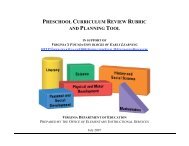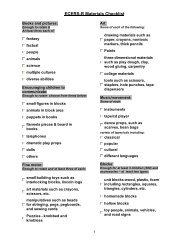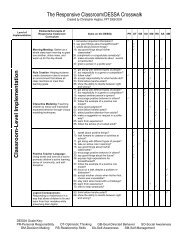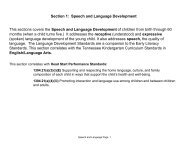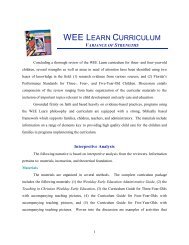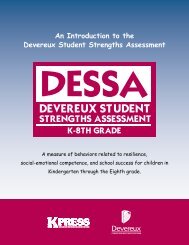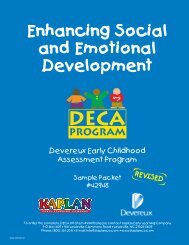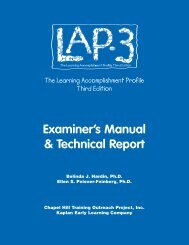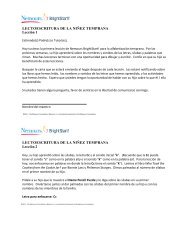Examiner's Manual & Technical Report - Kaplanco.com
Examiner's Manual & Technical Report - Kaplanco.com
Examiner's Manual & Technical Report - Kaplanco.com
- No tags were found...
You also want an ePaper? Increase the reach of your titles
YUMPU automatically turns print PDFs into web optimized ePapers that Google loves.
indicate strong correlations (.74 to .90) between chronological age and raw scores for thedomains and subscales as well as good reliability based on test-retest correlations (.87 to .99) andinterrater reliability correlations (.74 to .90) across both language groups. Construct and criterionvalidity results also indicate that the LAP-D is a very valid instrument when <strong>com</strong>pared with otherestablished instruments. See Chapters 5 and 6 for detailed information about the LAP-D normingstudy.LAP-D ContentBecause the LAP-D is a norm-referenced assessment, its overall purpose is to provide a standardagainst which a child’s development in specific content areas can be measured. The LAP-Dcovers four major domains of development, with two subscales for each domain: Fine Motor:(Writing & Manipulation); Cognitive (Counting & Matching); Language (Naming &Comprehension); and Gross Motor (Body Movement & Object Movement). Items are arrangedin sequential order of difficulty within each subscale, based on normative patterns ofdevelopment. Items are grouped into developmental age categories representing the typical ageat which most children can perform these tasks. This third edition of the LAP-D has retained thesame structure as the previous version, as well as most of the same items. The goal of thisrevision was to make as few changes as possible to the instrument, but to enhance itspsychometric integrity where needed. The legitimate problem of assigning a behavior to onespecific area of development continues to be challenging for test developers. While it isinappropriate to ignore overlap between areas of development (e.g., cognition/language or finemotor/gross motor), the authors believe that for purposes of programming, the instrument shouldfocus on the primary developmental area reflected by a specific behavior.Some changes were made in the location of the developmental milestones to strengthen theassociation between chronological age and the placement of items within the developmental agecategories. These changes were based on item analyses of each language group separately aswell as the total project sample, and were only instituted when the change improved theproperties of both language versions.As a result of these analyses, items were re-arranged within age levels from least to mostdifficult or moved to a different age level to better ac<strong>com</strong>modate the basal and ceiling format ofthe assessment. As indicated in Table 1, items were moved within an age range sequence ormoved to another age range. However, it should be noted that these changes also affected thenumbering of surrounding items.10




